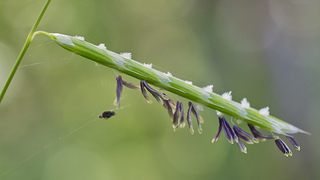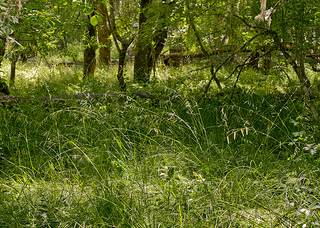(Pleuropogon hooverianus)
 Pleuropogon hooverianus. CDFW photo by Jeb Bjerke.
Pleuropogon hooverianus. CDFW photo by Jeb Bjerke.
 Pleuropogon hooverianus habitat. CDFW photo by Jeb Bjerke.
Pleuropogon hooverianus habitat. CDFW photo by Jeb Bjerke.
North Coast semaphore grass is a California threatened plant species, which means that killing or possession of plants is prohibited by the California Endangered Species Act (CESA). North Coast semaphore grass is a tall perennial bunchgrass, with upright flowering stems that grow more than 36 inches tall and occasionally bend downwards. The flowers typically appear in late April, May, and June. North Coast semaphore grass has been found growing in meadow openings within forests or woodlands that are typically saturated with standing water during the winter months and receive partial shade from adjacent trees. North Coast semaphore grass is only found at disjunct locations in Marin, Sonoma, and Mendocino Counties. At the time of this webpage posting, there were 21 occurrences of North Coast semaphore grass in the California Natural Diversity Database that were presumed to still exist.
Almost all known North Coast semaphore grass populations are located on privately-owned lands. Habitat destruction and modification from agricultural conversion and timber harvest activities, roadside maintenance practices, weed control, and ditch excavation and maintenance on these lands have all adversely affected North Coast semaphore grass and remain potential threats. Competition from invasive plants is a threat to the species, and changes in hydrology or prolonged drought could create conditions that are more favorable to species that could out-compete North Coast semaphore grass. Natural successional changes in habitat, climate change, and the vulnerability of small populations to random events and genetic effects could also threaten North Coast semaphore grass.
Efforts should be made secure protection of remaining North Coast semaphore grass habitat and to conduct surveys for additional populations of the species. Research should be conducted on the habitat requirements of North Coast semaphore grass, the size and viability of the soil seed bank, the genetic diversity within and between populations, and the best methods for management of competing vegetation. Remaining populations should be monitored using standardized protocols, and invasive vegetation that competes with North Coast semaphore grass may need to be periodically controlled using the best available practices.
CDFW may issue permits for North Coast semaphore grass pursuant to CESA, and you can learn more about the California laws protecting North Coast semaphore grass and other California native plants. Populations of North Coast semaphore grass occur in CDFW’sNorthern Region and Bay Delta Region.
Updated 6/24/14